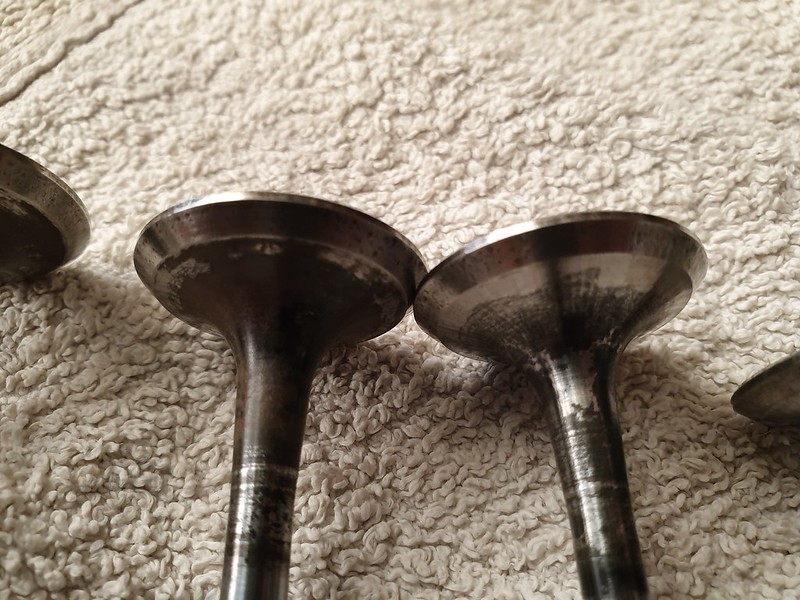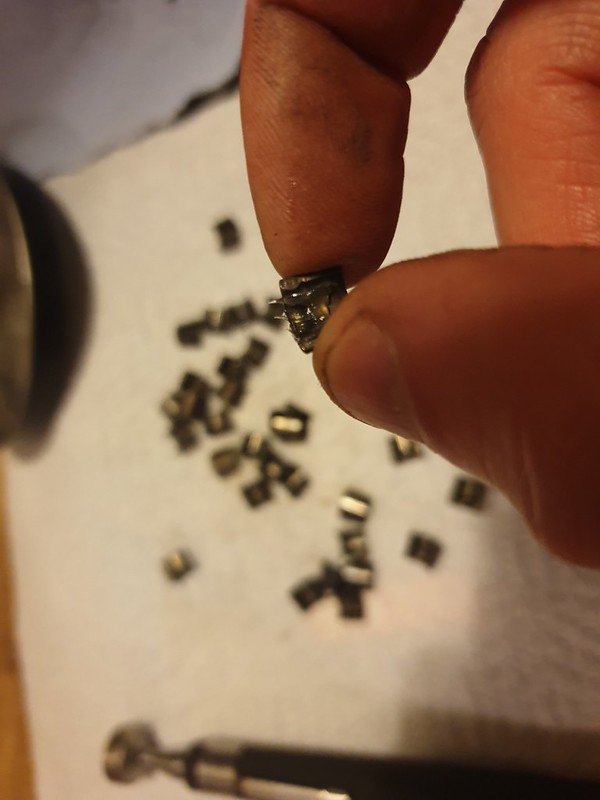Post #871
I dragged a spare bottom end out of the shed and set to work stripping it down.
 20191215_130848
20191215_130848 by
Steve Count, on Flickr
After a couple of hours attacking it with wire wheels
 20191230_123410
20191230_123410 by
Steve Count, on Flickr
After a couple of coats of red oxide primer
 20191230_132041
20191230_132041 by
Steve Count, on Flickr
Three coats of halfords red engine enamel
 20191231_144240
20191231_144240 by
Steve Count, on Flickr
Mounted the gearbox up and marked where paint needed removing to ensure the bellhousing sat flush with the block then took the paint away with a wire wheel where needed
 20200102_121704
20200102_121704 by
Steve Count, on Flickr
Bought myself a honing tool for christmas and set about honing the bores, used loads of wd40 to keep things lubricated.
 20200102_124403
20200102_124403 by
Steve Count, on Flickr
The only picture i seem to have got of the bores, this was after a few passes just to see how fast i needed the speed and how quick i needed to go up and down in the bores to get a decent cross-hatch. I removed the oil spray bars so the hone could go to the bottom of each bore. I masked as much as i could of the main journals and the oil spray bar oil feed holes to stop any crap getting into the oil galleries.
 20200102_130220
20200102_130220 by
Steve Count, on Flickr
After honing I cleaned everything down thoroughly with hot water and washing up liquid, then blasted everything with the hose pipe. Next was blasting it with the air line, then going over everything again with copious amounts of brake cleaner. I kept wiping the bores with fresh blue rag soaked in brake cleaner until they were coming out with no evidence of any honing debris. Next a quick spray over with wd40 to stop any rust forming.
The oil galleries were blasted with a few cans of brake cleaner to make sure there was nothing bad in them. Likewise the crank had all the oil ways blasted until the brake cleaner was coming out clear.
Next i refitted the oil spray bars
 20200102_164627
20200102_164627 by
Steve Count, on Flickr
I bought 4 new sets of Mahle piston rings. The documents didn't specify anything for what the ring gap should be so I emailed them. They just said the rings come pre-gapped and didn't acknowledge any need for bigger gaps with the engine being boosted.
I numbered the piston ring packs 1-4, and kept each set of rings in the relevant pack and assigned them to each cylinder. I inserted each ring into its corresponding bore and used a piston to push the ring down the bore nice and square then used feeler gauges to measure the ring gaps. I did this for the top and middle rings and noted the gaps.
 20200102_171448
20200102_171448 by
Steve Count, on Flickr
 20200102_165906
20200102_165906 by
Steve Count, on Flickr
 20200102_165615
20200102_165615 by
Steve Count, on Flickr
After i'd done them all they all seemed to be pretty much the same so i went ahead and fitted them to the pistons.
Next up i made sure all the main journals were clean and fitted the new main shells to the block and dropped in the crank.
I know it's not a perfect way of measuring anything but it's good as an indication of clearance so i went ahead and got the plastigauge out and measured all the main journal clearances. Torqued the caps down to the recommended specs.
 20200103_133535
20200103_133535 by
Steve Count, on Flickr
 20200103_133551
20200103_133551 by
Steve Count, on Flickr
 20200103_134942
20200103_134942 by
Steve Count, on Flickr
 20200103_135009
20200103_135009 by
Steve Count, on Flickr
The plastigauge readings were all pretty similar and from memory they are within spec of what the clearance should be so I cleaned all the plastigauge off, removed the crank and went ahead with coating the bearings with graphogen assembly compound. I then refitted all the main caps and torqued them all back down to spec, not forgetting to fit the thrust bearings.
Now that i could rotate the crank I checked the end float. When putting #1 main cap in i fitted new hockey stick seals and added a thin bead of sealant just incase the rubber didnt create a perfect seal.
 20200103_141046
20200103_141046 by
Steve Count, on Flickr
 20200103_141144
20200103_141144 by
Steve Count, on Flickr
 20200103_142239
20200103_142239 by
Steve Count, on Flickr
 20200103_135912
20200103_135912 by
Steve Count, on Flickr
 20200103_140754
20200103_140754 by
Steve Count, on Flickr
 20200103_140757
20200103_140757 by
Steve Count, on Flickr
Thats 0.14mm of end float, which is between the tolerances i found of 0.07 - 0.27mm online.
Next job was to fit the pistons and rods. Firstly i went over each bore again with brake cleaner on blue roll then I coated all the bores and piston ring compressor with fresh engine oil to help keep everything lubricated, and gave the skirts of the pistons a wipe over with engine oil too.
 20200104_122553
20200104_122553 by
Steve Count, on Flickr
Once again I used plastigauge to get an idea of clearance for each big end, torquing the caps down as they should be.
 20200104_112705
20200104_112705 by
Steve Count, on Flickr
 20200104_120536
20200104_120536 by
Steve Count, on Flickr
They were all pretty much the same and once again they were within tolerance from memory.
The journals don't look too pretty in the pictures but i ran a fingernail over each one and couldnt feel anything. I also had a micrometer on all the big end journals and all measured mid-tolerance.
After plastigauging i cleaned all the plastigauge off, coated the moving faces with graphogen then torqued the caps down.
The crank could be rotated by hand at this point which is reassuring that nothing is binding. I probably should have mentioned earlier but each time i torqued down a main cap i'd try and give the crank a turn to make sure it wasnt binding, likewise with each big end.
Next up i fitted the windage tray
 20200104_130755
20200104_130755 by
Steve Count, on Flickr
The oil pump sprocket that was used previously on the engine was the old design where the sprocket relies purely on the pulley bolt being tight enough to clamp it and stop it spinning. I then raided one of my other engines for the newer design sprocket where the sprocket and spacer part are one piece which then means the woodruff key positively drives it ensuring it is locked to the crank regardless of how tight the crank pulley bolt is.
 20200104_132035
20200104_132035 by
Steve Count, on Flickr
 20200104_132155
20200104_132155 by
Steve Count, on Flickr
Oil pump and chain fitted. Don't forget the 'L' shim. Loctite used on all the bolts.
 20200104_133433
20200104_133433 by
Steve Count, on Flickr
 20200104_133741
20200104_133741 by
Steve Count, on Flickr
Reinserted the dipstick tube and bolted it in place on the oil pump
 20200104_133758
20200104_133758 by
Steve Count, on Flickr
I'd bought the Payen gasket kit for the rebuild, and also bought new crank seals. New seal fitted to the engine end plate after cleaning it and applying a bead of sealant to the mating surface.
 20200102_171830
20200102_171830 by
Steve Count, on Flickr
 20200104_135810
20200104_135810 by
Steve Count, on Flickr
Next up i fitted the cambelt pulley and billet crank pulley and spun the crank so the pulley hole lined up with the locking point on the engine making sure the pistons were all mid-stoke. I'd also fitted the water pump along with a new gasket and both the tensioner pulley and idler pulley for the cambelt. Also the two dowels to locate the head in the correct position. Also cleaned out the sump and fitted it with a bead of sealant around the mating faces. Not shown in these pictures but done at this stage was locking the crank in place using an 8mm drill blank.
 20200104_150609
20200104_150609 by
Steve Count, on Flickr
 20200104_160314
20200104_160314 by
Steve Count, on Flickr
Placed the new head gasket in place, ensuring the dowels held it in place.
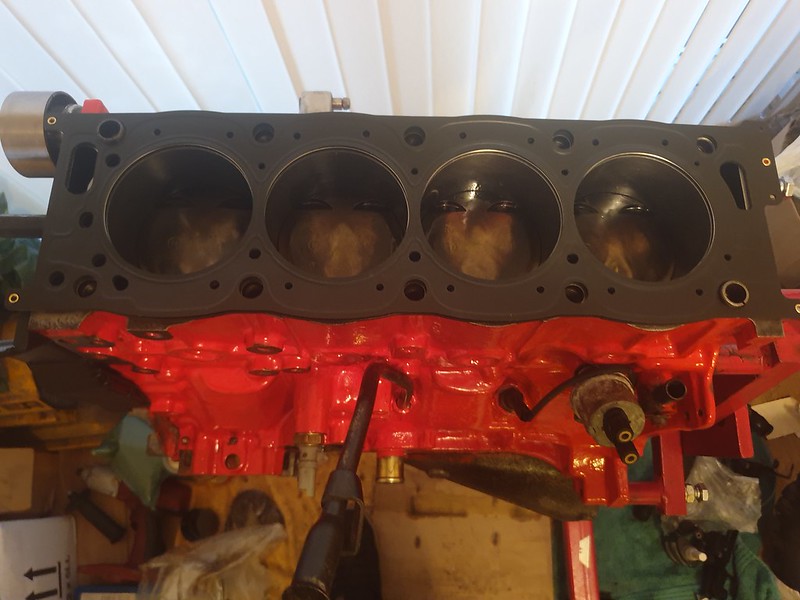 20200104_160444
20200104_160444 by
Steve Count, on Flickr
Carefully put the head back on being careful to line up the dowels and not scrape/damage the mating face.
 20200104_160734
20200104_160734 by
Steve Count, on Flickr
Next up I fitted new head bolts and torqued them down in the correct sequence to the torque rating in each stage. The final stage is 160*, which is quite hard work doing it on your own when the engine stand is on wheels and wants to spin


I managed it in the end by standing on the stand base.
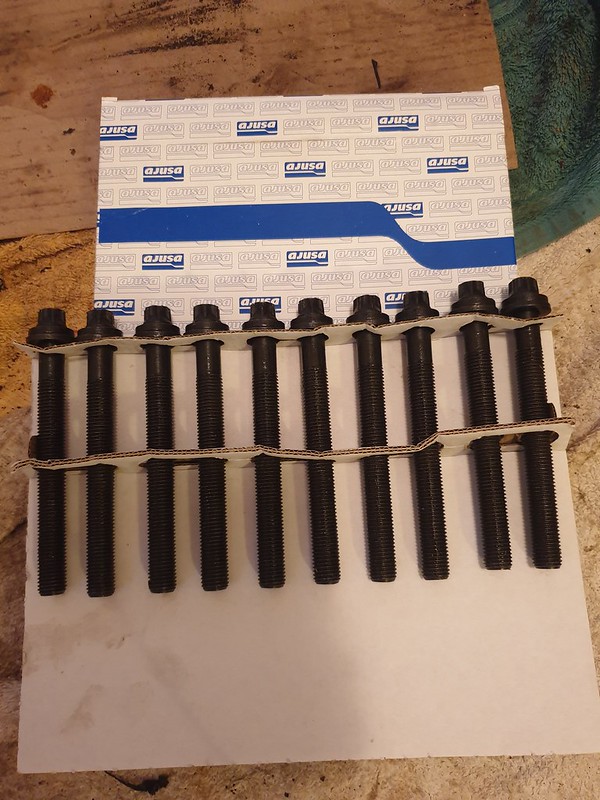 20200104_160858
20200104_160858 by
Steve Count, on Flickr
Next up was to apply graphogen to the hydraulic lifters, ensuring each one went in the bore it came out of originally. I do this by using seperate food bags for each one and putting that bag inside another food bag with a piece of card labelled to identify where it should live. i.e. 'In1', 'In2', 'Ex1', 'Ex2' etc I put the various other bits of the valvetrain in bags like this too.
 20200104_174104
20200104_174104 by
Steve Count, on Flickr
Next up I made sure the exhaust cam was clean. I fitted the pulley to the end and did the bolt up finger tight. I applied sealant to the mating face where the cam carrier meets the head, applied graphogen to the lobes and all the journals, then laid the camshaft in the journals so that the locking hole was slightly anti-clockwise to the locking hole on the head.
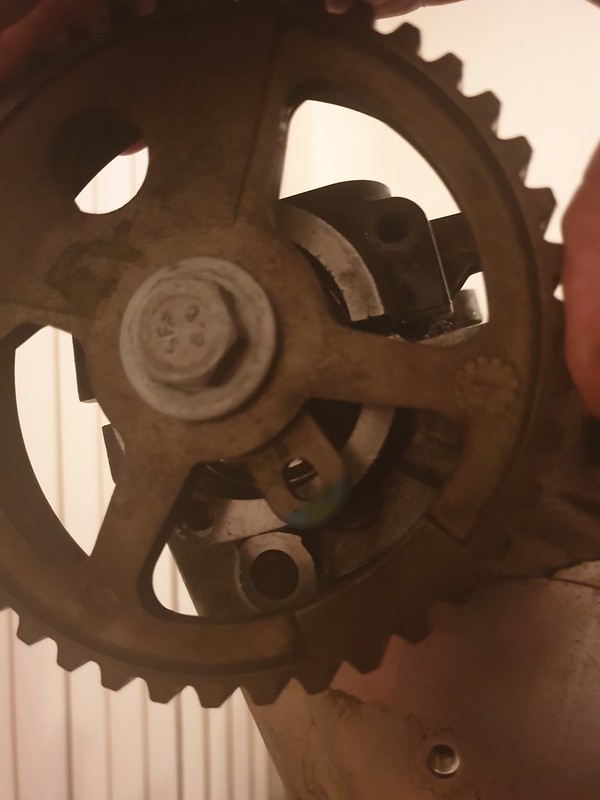 20200104_180801
20200104_180801 by
Steve Count, on Flickr
Next i then tighten down the cam carrier capscrews, the final sequence spiraling out from the centre much like doing the head bolts.
With the carrier clamped down i then insert the new seal, using a bit of tube to ensure it's located flush and square.
 20200104_181640
20200104_181640 by
Steve Count, on Flickr
 20200104_181653
20200104_181653 by
Steve Count, on Flickr
 20200104_181736
20200104_181736 by
Steve Count, on Flickr
Don't forget the oil spray bar
 20200104_182526
20200104_182526 by
Steve Count, on Flickr
Do exactly the same for the inlet cam side
 20200104_190453
20200104_190453 by
Steve Count, on Flickr
Pulleys back off to fit the cambelt cover
 20200104_191444
20200104_191444 by
Steve Count, on Flickr
Pulleys back on, now you want to use an 18mm spanner on the camshaft pulley bolts to carefully rotate the camshaft clockwise whilst you use a 6mm drill blank to lock the camshaft in place with the relevant hole in the head. Once each cam has been locked in place carefully crack off the bolts so the pulley can rotate on the camshafts, rotate them as far clockwise as possible by hand, then place the cambelt round the bottom pulley, round the idler pulley, over the inlet cam pulley, round the exhaust cam pulley, round the tensioner pulley then water pump and back round the crank pulley. The crank pulley should be locked in place with an 8mm drill blank.
A better description of this process can be found in the FAQ guide on this forum along with more pictures along the way.
Once the belt is in place use the tensioner to set the belt tension and nip it in place. Tighten the cam pulley bolts and remove all three locking pins. Rotate the crankshaft clockwise carefully multiple times then try fitting the drill blanks back into all 3 locking holes. If they line up then great, if not then you've gone wrong somewhere. If everything is as it should be torque everything to the correct torque and make sure you applied loctite to the bolts so they wont rattle loose in the future.
 20200104_193951
20200104_193951 by
Steve Count, on Flickr
 20200104_201350
20200104_201350 by
Steve Count, on Flickr
This is as far as i've got so far, i'm still waiting for new flywheel bolts and the m20x1.5 oil filter tube to come in at the local dealers.
________________________________________
Goldie the track car.

 20190907_154141 by Steve Count, on Flickr
20190907_154141 by Steve Count, on Flickr




 prism7guy
prism7guy
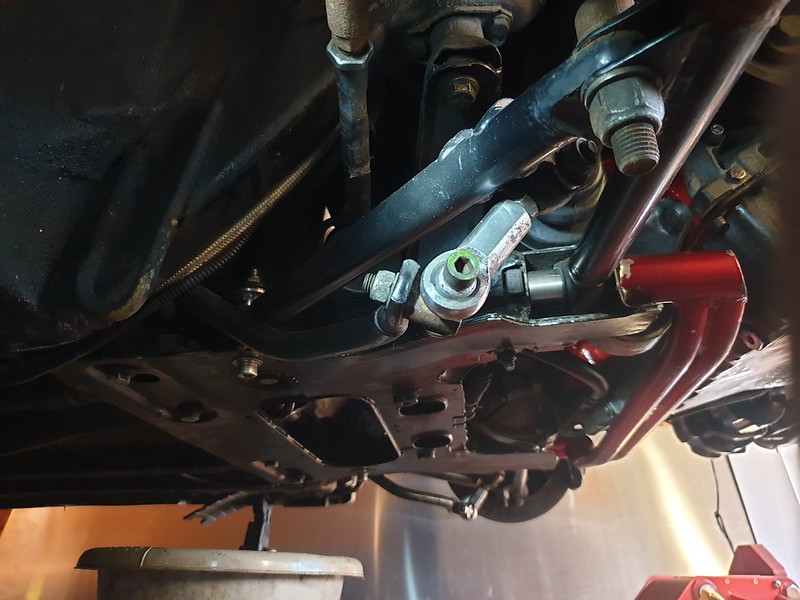























 - (The other half's wheels)
- (The other half's wheels)













